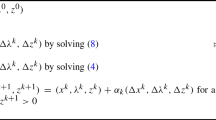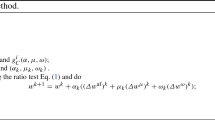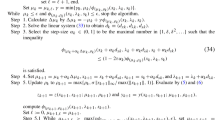Abstract
This paper is concerned with selection of theρ-parameter in the primal—dual potential reduction algorithm for linear programming. Chosen from [n +\(\sqrt n \), ∞), the level ofρ determines the relative importance placed on the centering vs. the Newton directions. Intuitively, it would seem that as the iterate drifts away from the central path towards the boundary of the positive orthant,ρ must be set close ton +\(\sqrt n \). This increases the relative importance of the centering direction and thus helps to ensure polynomial convergence. In this paper, we show that this is unnecessary. We find for any iterate thatρ can be sometimes chosen in a wide range [n +\(\sqrt n \), ∞) while still guaranteeing the currently best convergence rate of O(\(\sqrt n \) L) iterations. This finding is encouraging since in practice large values ofρ have resulted in fast convergence rates. Our finding partially complements the recent result of Zhang, Tapia and Dennis (1990) concerning the local convergence rate of the algorithm.
Similar content being viewed by others
References
K.M. Anstreicher and R.A. Bosch, “Long steps in an O(n 3 L) algorithm for linear programming,”Mathematical Programming 54 (1992) 251–265.
R.M. Freund, “Polynomial-time algorithms for linear programming based only on primal scaling and projected gradients of a potential function,”Mathematical Programming 51 (1991) 203–222.
C.C. Gonzaga, “An algorithm for solving linear programming problems in O(n 3 L) operations,” in: N. Megiddo, ed.,Progress in Mathematical Programming-Interior Point and Related Methods (Springer, New York, 1989) pp. 1–28.
C.C. Gonzaga and M.J. Todd, “An O(\(\sqrt n \) L)-iteration large-step primal—dual affine algorithm for linear programming,” to appear inSIAM Journal on Optimization.
C.-G. Han, P.M. Pardalos and Y. Ye, “Computational aspects of an interior point algorithm for quadratic programming problems with box constraints,” in: T.F. Coleman and Y. Li, eds.,Large-Scale Numerical Optimization (SIAM, Philadelphia, PA, 1990) pp. 92–112.
S. Huang and K.O. Kortanek, “A simultaneous primal—dual potential reduction algorithm for linear programming,” to appear inOperations Research Letters.
S. Huang and K.O. Kortanek, “A hybrid polynomial algorithm for linear programming,” Working Paper Series 89-25, Department of Management Sciences, The University of Iowa (Iowa City, IA, 1989).
N. Karmarkar, “A new polynomial-time algorithm for linear programming,”Combinatorica 4 (1984) 373–395.
M. Kojima, N. Megiddo, T. Noma and A. Yoshise, “A unified approach to interior point algorithms for linear complementarity problems,” Presentation at theSecond Asilomar Workshop on Progress in Mathematical Programming (Asilomar, CA, 1990).
M. Kojima, N. Megiddo and Y. Ye, “An interior point potential reduction algorithm for the linear complementarity problem,”Mathematical Programming 54 (1992) 267–279.
M. Kojima, S. Mizuno and A. Yoshise, “An O(\(\sqrt n \) L) iteration potential reduction algorithm for linear complementarity problems,”Mathematical Programming 50 (1991) 331–342.
M. Kojima, S. Mizuno and A. Yoshise, “A polynomial-time algorithm for a class of linear complementarity problems,”Mathematical Programming 44 (1989) 1–26.
M. Kojima, S. Mizuno and A. Yoshise, “A primal—dual interior point method for linear programming,” in: N. Megiddo, ed.,Progress in Mathematical Programming — Interior Point and Related Methods (Springer, New York, 1989) pp. 29–47.
S. Liu and D. Goldfarb, “Interior point potential function reduction algorithms for solving convex quadratic programs,” manuscript, Department of IEOR, Columbia University (New York, NY, 1989).
K.A. McShane, C.L. Monma and D.F. Shanno, “An implementation of a primal—dual interior point method for linear programming,”ORSA JOurnal on Computing 1 (1989) 70–83.
N. Megiddo, “Pathways to the optimal set in linear programming,” in: N. Megiddo, ed.,Progress in Mathematical Programming — Interior Point and Related Methods (Springer, New York, 1989) pp. 131–158.
R.C. Monteiro and I. Adler, “An O(n 3 L) primal—dual interior point algorithm for linear programming,”Mathematical Programming 44 (1989) 27–42.
R.C. Monteiro, I. Adler and M.C. Resende, “A plynomial-time primal—dual affine scaling algorithm for linear and convex quadratic programming and its power series extension,”Mathematics of Operations Research 15 (1990) 191–214.
J. Renegar, “A polynomial-time algorithm, based on Newton's method, for linear programming,”Mathematical Programming 40 (1988) 59–93.
K. Tanabe, “Complementary-enforcing centered Newton method for mathematical programming,” in: K. Tone, ed.,New Methods for Linear Programming (The Institute of Statistical Mathematics, Tokyo, 1987) pp. 118–144.
M.J. Todd and Y. Ye, “A centered projective algorithm for linear programming,”Mathematics of Operations Research 15 (1990) 508–529.
Y. Ye, “An O(n 3 L) potential reduction algorithm for linear programming,”Mathematical Programming 50 (1991) 239–258.
Y. Ye, “Line search in potential reduction algorithms for linear programming,” manuscript (1989).
Y. Ye, “Bimatrix equilibrium points and potential functions, linear programming,” Working Paper Series 88-16, Department of Management Sciences, The University of Iowa (Iowa City, IA, 1988).
Y. Zhang, R.A. Tapia and J.E. Dennis, “On the superlinear and quadratic convergence of primal—dual interior point linear programming algorithms,” TR90-6, Department of Mathematical Sciences, Rice University (Houston, TX, 1990).
Author information
Authors and Affiliations
Additional information
Research supported in part by NSF Grant DDM-8922636.
Rights and permissions
About this article
Cite this article
Ye, Y., Kortanek, K.O., Kaliski, J. et al. Near boundary behavior of primal—dual potential reduction algorithms for linear programming. Mathematical Programming 58, 243–255 (1993). https://doi.org/10.1007/BF01581269
Received:
Revised:
Issue Date:
DOI: https://doi.org/10.1007/BF01581269




